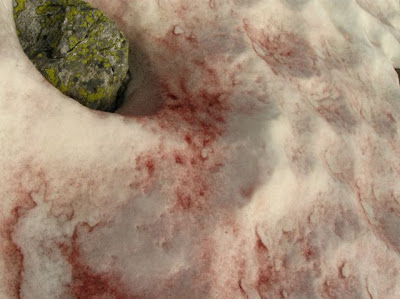This phenomenon is especially common during the summer months in the Sierra Nevada of California where snow has lingered from winter storms, mainly at altitudes of 10,000 to 12,000 feet. Compressing the snow with your boot leaves a distinct footprint the color of watermelon pulp. The snow even has a fresh watermelon scent and is sometimes called "watermelon snow." Walking in pink snow often results in a temporary discoloration of your clothing, such as bright red soles and pinkish pant cuffs. It was not until the end of the nineteenth century that the unusual phenomenon was finally attributed to high concentrations or "blooms" of microscopic algae. In the high mountain ranges of the western United States at least 60 different species of snow algae have been identified, but only a few kinds have been reported from the Sierra Nevada. One of the most common species of snow algae in California, and the one responsible for pink snow, is Chlamydomonas nivalis. This unicellular organism is a member of the diverse green algae Division Chlorophyta (Order Volvocales), and contains a bright red carotenoid pigment in addition to chlorophyll. Unlike most species of fresh-water algae, it is cryophilic (cold-loving) and thrives in freezing water. Its scientific surname, nivalis, is from Latin and refers to snow. Compressing pink snow with your boot increases the density of the red cells and heightens the color.

The first accounts of watermelon snow are in the writings of Aristotle. Watermelon snow has puzzled mountain climbers, explorers, and naturalists for thousands of years, some speculating that it was caused by mineral deposits or oxidation products that were leached from rocks.













If you ever get a chance to hike in the Sierra Nevada, keep in mind that yellow snow doesn’t have a lemon aroma or taste. Don’t eat it :)
















No comments:
Post a Comment